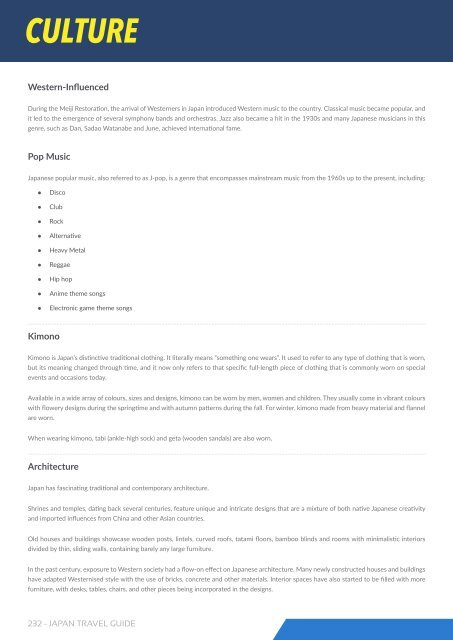- Page 2 and 3:
table of contents Country Overview
- Page 4 and 5:
Overview Japan is an archipelago of
- Page 6 and 7:
Overview Kyoto With a population of
- Page 8 and 9:
5 Reasons You’ll Love travelling
- Page 10 and 11:
Map of Japan 10 - Japan Travel Guid
- Page 12 and 13:
Top 20 Experiences With its evocati
- Page 14 and 15:
Top 20 Experiences Go Shopping Shop
- Page 16 and 17:
General Information 16 - Japan Trav
- Page 18 and 19:
Accommodation: Ryokan In onsen town
- Page 20 and 21:
asics Visa Information Australians
- Page 22 and 23:
asics Emergencies Japan has nationw
- Page 24 and 25:
Costs and Budgets The cost of trave
- Page 26 and 27:
Costs and Budgets Food While in Jap
- Page 28 and 29:
Cultural Tips and Courtesy Avoid bu
- Page 30 and 31:
Japanese Phrases While Travelling C
- Page 32 and 33:
Japanese Phrases While Travelling
- Page 34 and 35:
Luggage and Luggage Services Having
- Page 36 and 37:
Transportation + Guide to Japanese
- Page 38 and 39:
Transportation + Guide to Japanese
- Page 40 and 41:
GUIDE TO JAPANESE IC CARDS Are Ther
- Page 42 and 43:
How to Travel by Train How to buy a
- Page 44 and 45:
What to Pack The type of clothing,
- Page 46 and 47:
Internet and Mobile Advice Having i
- Page 48 and 49:
Travel Guides 48 - Japan Travel Gui
- Page 50 and 51:
Tokyo Travel Guide Things To See To
- Page 52 and 53:
Where to Stay in Tokyo Tokyo is one
- Page 54 and 55:
Where to Stay in Tokyo ● For Japa
- Page 56 and 57:
How to Navigate Tokyo’s Train Sys
- Page 58 and 59:
Kyoto Travel Guide Overview A forme
- Page 60 and 61:
Kyoto Travel Guide ● ● ● Down
- Page 62 and 63:
How to get around Kyoto How to ride
- Page 64 and 65:
Immerse Yourself in Kyoto Culture K
- Page 66 and 67:
Osaka Travel Guide Overview Osaka i
- Page 68 and 69:
Osaka Travel Guide Getting Around T
- Page 70 and 71:
Yokohama Travel Guide Things To See
- Page 72 and 73:
Hiroshima Travel Guide Overview Hir
- Page 74 and 75:
Guide to Miyajima Using Your Japan
- Page 76 and 77:
Nara Travel Guide Overview Located
- Page 78 and 79:
Nara Travel Guide Where To Explore
- Page 80 and 81:
Takayama Travel Guide Things To See
- Page 82 and 83:
Fukuoka Travel Guide Overview The l
- Page 84 and 85:
Fukuoka Travel Guide Where To Explo
- Page 86 and 87:
Kobe Travel Guide Things To See Eat
- Page 88 and 89:
Nagoya Travel Guide Overview The fo
- Page 90 and 91:
Nagoya Travel Guide Where To Explor
- Page 92 and 93:
Kamakura Travel Guide Things To See
- Page 94 and 95:
Sendai Travel Guide Overview Home t
- Page 96 and 97:
Sendai Travel Guide Where To Explor
- Page 98 and 99:
Sapporo Travel Guide Things To See
- Page 100 and 101:
Okinawa Travel Guide Overview The s
- Page 102 and 103:
Nikko Travel Guide Overview A city
- Page 104 and 105:
Nikko Travel Guide Where To Explore
- Page 106 and 107:
Nagano Travel Guide Things To See V
- Page 108 and 109:
Nagasaki Travel Guide Things To See
- Page 110 and 111:
Hakone Travel Guide Things To See R
- Page 112 and 113:
Kagoshima Travel Guide Overview Sit
- Page 114 and 115:
Kanazawa Travel Guide Overview Kana
- Page 116 and 117:
Kanazawa Travel Guide Getting Aroun
- Page 118 and 119:
Shibuya Crossing 7 DAY PASS - JAPAN
- Page 120 and 121:
7 DAY PASS - JAPAN ESSENTIALS ITINE
- Page 122 and 123:
7 DAY PASS - Basic Itinerary Shibuy
- Page 124 and 125:
7 DAY PASS - Autumn Country Itinera
- Page 126 and 127:
7 DAY PASS - Autumn Country Itinera
- Page 128 and 129:
7 DAY PASS - Cherry Blossoms Deligh
- Page 130 and 131:
7 DAY PASS - Cherry Blossoms Deligh
- Page 132 and 133:
7 DAY PASS - Travel With Kids Itine
- Page 134 and 135:
7 DAY PASS - Travel With Kids Itine
- Page 136 and 137:
14 DAY PASS - East to South Itinera
- Page 138 and 139:
14 DAY PASS - East to South Itinera
- Page 140 and 141:
14 Day Pass - Off The Beaten Track
- Page 142 and 143:
14 Day Pass - Off The Beaten Track
- Page 144 and 145:
Shirakawago 14 DAY PASS - Honeymoon
- Page 146 and 147:
14 DAY PASS - Honeymoon Itinerary D
- Page 148 and 149:
14 DAY PASS - Honeymoon Itinerary N
- Page 150 and 151:
14 DAY PASS - BEST OF THE WEST CHER
- Page 152 and 153:
14 DAY PASS - BEST OF THE WEST CHER
- Page 154 and 155:
Happoike Pond - Hakuba Valley 14 DA
- Page 156 and 157:
14 DAY PASS - ACTIVE ITINERARY Day
- Page 158 and 159:
14 Day Pass - Summer adventure Itin
- Page 160 and 161:
14 Day Pass - Summer adventure Itin
- Page 162 and 163:
14 Day Pass - Summer adventure Itin
- Page 164 and 165:
14 DAY PASS - WINTER EXPLORER ITINE
- Page 166 and 167:
14 DAY PASS - WINTER EXPLORER ITINE
- Page 168 and 169:
21 Day Pass - Discover Japan by Rai
- Page 170 and 171:
21 Day Pass - Discover Japan by Rai
- Page 172 and 173:
21 Day Pass - Discover Japan by Rai
- Page 174 and 175:
21 Day Pass - Discover Japan by Rai
- Page 176 and 177:
Fuji-Q Highland - ©JNTO Amusement
- Page 178 and 179:
Amusement Parks The park also has r
- Page 180 and 181:
Castles ● ● ● Stone walls - C
- Page 182 and 183: Cherry Blossom Nagano ● ● Matsu
- Page 184 and 185: Awa Odori Dance - ©JNTO Festivals
- Page 186 and 187: Festivals Autumn ● ● Jidai Mats
- Page 188 and 189: Food and Drinks + 7 Snacks to Try
- Page 190 and 191: 7 Japanese Snacks That everyone Sho
- Page 192 and 193: Gardens Japan boasts many gardens t
- Page 194 and 195: Gardens Ryoanji Best visited early
- Page 196 and 197: Historical Sites Ogimachi Village L
- Page 198 and 199: Manga and Anime Manga Manga are Jap
- Page 200 and 201: Museums Japan is home to numerous m
- Page 202 and 203: Museums 21st Century Museum of Cont
- Page 204 and 205: Nightlife Top Japanese Nightlife Di
- Page 206 and 207: Onsen Time To Relax Beppu Onsen Mud
- Page 208 and 209: Shopping & Must Buy Souvenirs Japan
- Page 210 and 211: 7 Must-Buy Japanese Souvenirs Think
- Page 212 and 213: Shrines ● ● ● ● ● ● ●
- Page 214 and 215: Skiing Zao Ski Resort Located in Ya
- Page 216 and 217: Snow ● ● Manza Onsen - Sitting
- Page 218 and 219: Temples Common Features Temples in
- Page 220 and 221: Learn 220 - Japan Travel Guide
- Page 222 and 223: Brief History of Japan Medieval Per
- Page 224 and 225: Bullet Train & History In addition,
- Page 226 and 227: Bullet Train & History Displays on
- Page 228 and 229: Climate The climate in Japan varies
- Page 230 and 231: Culture Japan has a multi-faceted c
- Page 234 and 235: Culture Festivals Most Japanese fes
- Page 236 and 237: Geography Volcanoes, Earthquakes, a
- Page 238 and 239: People Arts and Literature Japanese
- Page 240 and 241: Religion When Buddhism found its wa
- Page 242 and 243: Sports Sports are a big part of the
- Page 244 and 245: The Geisha Geisha, also known as ge
- Page 246 and 247: Traditional Accommodation For trave
- Page 248 and 249: Traditional Accommodation Minshuku



